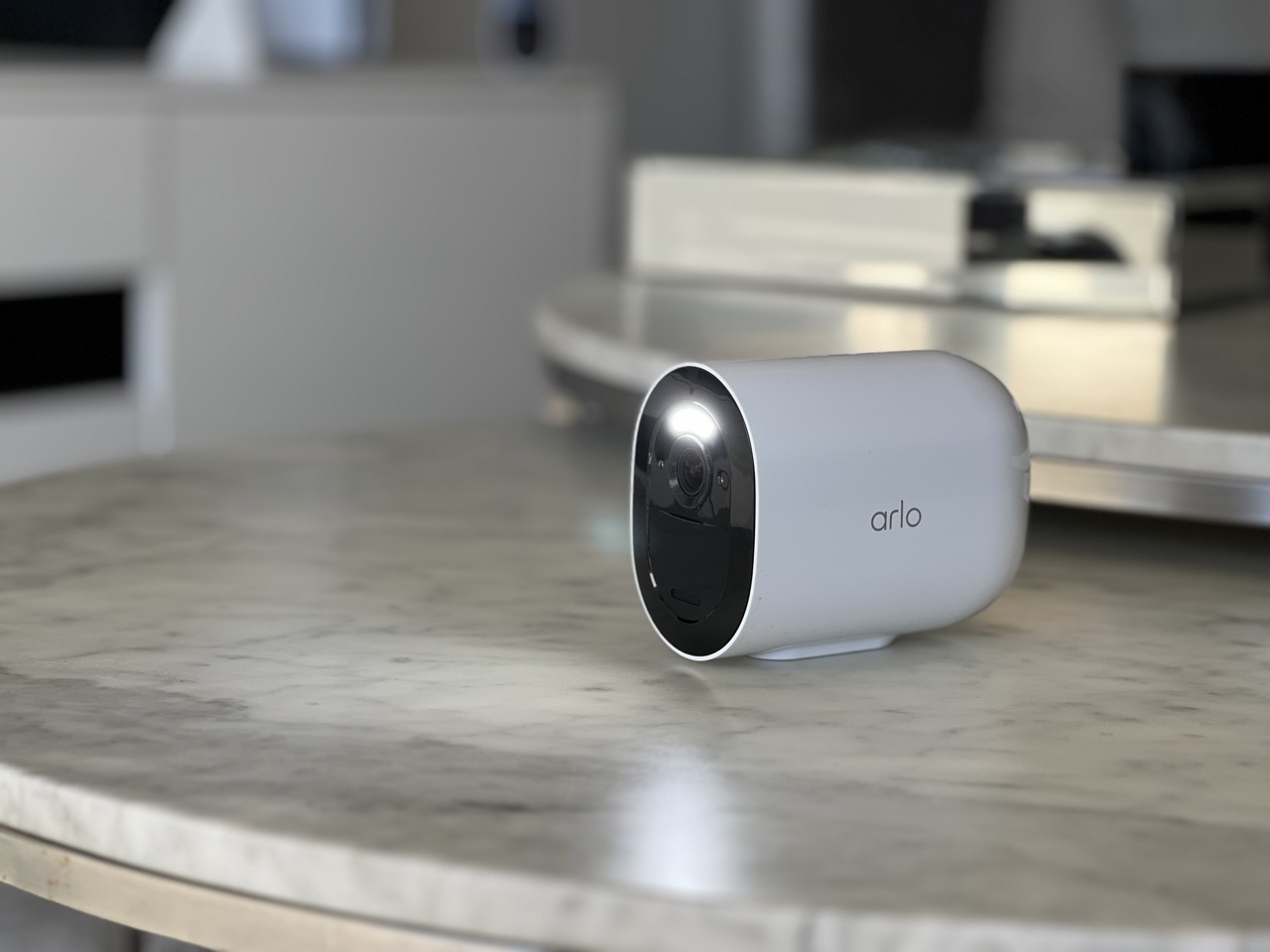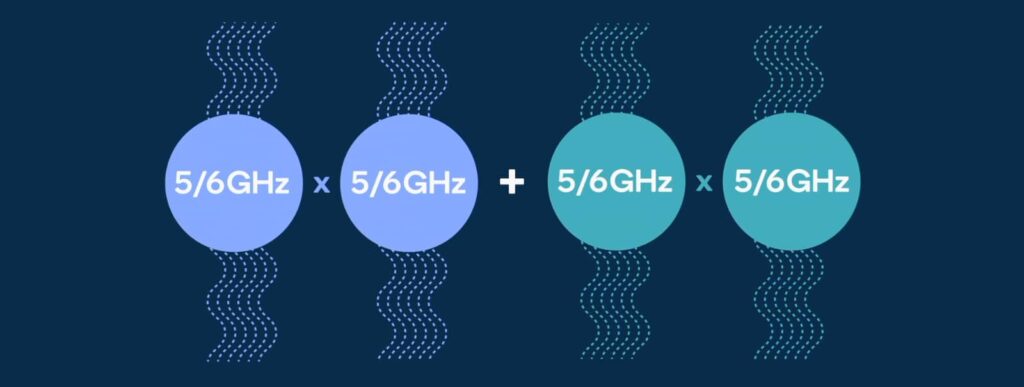The Arlo Go 2 is a specialized security camera. While you can connect it to your Wi-Fi network, it has its own LTE (4G) connection as well. This means that you can use it in places where you might not have a Wi-Fi signal, such as on a far corner of your property, farmland, in boats and RVs, construction sites or even campsites. How you use it is up to you, and as it’s weather proof, you don’t need to keep it under cover. While it has a rechargeable battery, you can add an Arlo solar panel so you never need to recharge it or connect power cables. It will also keep working during a power outage. With all this in mind, we tested out the Go 2 to see how it worked on the, well, ‘go’.
first looks
First thing you’ll notice is that the Go 2 is fairly large compared to other Arlo cameras, such as the Ultimate, Pro or Essential models. This is likely because of its large battery rather than to make room for a 4G SIM card or LTE antennas. And it’s a good thing too, as you’ll want the battery to last as long as possible considering it might be far away or out of reach.
Getting the Go 2 up and running was farily straight forward, provided that your 4G SIM is already working. We used one from Amaysim but first needed to plug it into our phone to get it registered on the network. Once that was done and inserted into the Go 2’s SIM slot, we ran the Arlo Secure app to add it to the camera dashboard. Here, you’ll be given a choice of connecting it to a Wi-Fi network or using a 4G / LTE signal. We chose 4G and were then shown a QR code to point the camera at. If it successfully ‘sees’ the QR code, which it did in our case, it connects to the app and finishes the process.

Arlo Go 2 – Price and Features
- RRP: $429
- Warranty: 12 months
- 1080P (full HD) resolution
- Weatherproof case and seals
- color night vision
- Spotlight (illuminates up to 7.6 meters)
- 2-way talk (full duplex)
- Long battery life (13,000mAh)
- Wi-Fi & 4G (LTE) network compatibility
- mounting bracket
- GPS location tracking
- built in siren
- MicroSD memory card for local storage
The Go 2 is packed with features. The key differences that separate it from other Arlo security cameras, such as the Ultra, Pro and Essential models are its 4G connectivity, large battery and GPS location tracking. The 4G provides the ubiquity to use it anywhere there’s coverage, while the huge 13,0000mAh battery maximizes time between charges. This is especially handy if you place the Go 2 in a remote location.
The GPS tracking is a great way to locate your camera if it’s stolen or you have multiple units on your property, such as a farm, and need to see where each is situated. You check the Go 2’s located by visiting a map in the Arlo Secure app.
Other than these features, the Go 2 has a spotlight that can illuminate up to 7.5 meters and motion tracking can be set to 7 meters away.


And like the top of the Ultra range, the Go 2 has its own MicroSD card, so you can store videos in the unit itself instead of in the cloud.
For images and videos, there’s a 1080p / full HD sensor. This is lower than the Pro and Ultra’s 2K and 4K respectively. The resolution choice is likely to keep image sizes small, so they require less bandwidth to send to the cloud via the 4G network. Otherwise, there’s a similar 12x digital zoom, night vision and two-way talk as found in the Essential and Pro models.
Subscribe for more features
While you can buy security cameras for less, the more premium brands such as Arlo offer a lot of advanced capabilities as part of a subscription service called Arlo Secure. This includes object detection, which uses AI to analyze what your camera is ‘seeing’. It can detect pets, people, packages and vehicles, so you can choose what events you want to be notified about. You can also assign activity zones in your image and exclude areas that you don’t want the camera to notice. This helps cut down simple ‘movement’ notifications where things like a tree blowing in the wind might trigger an alert. See too many of these and you’ll stop paying attention to the important ones.
The Arlo secure plan gives you 30 days worth of storage for your videos, along with interactive notifications that embed the video clip into the message. There’s even continuous video recording for an additional fee.



Arlo Secure costs $4.49 per month for one camera or $14.99 for unlimited cameras. Without the subscription you still get access to live video streaming through the app and motion notifications. More Arlo Secure plan pricing.
in-action
Using the Arlo Go 2 is quite straightforward. You can mount the camera on the included bracket, which allows for a wide range of motion, or it can be placed on a shelf, desk or some other unobtrusive place.
The camera’s settings can be configured in the Arlo Secure app. This includes doing a motion test to decide how sensitive it should be, along with tweaks to camera brightness, low light settings, enabling the floodlight and more.


We added the Go 2 to our other Arlo cameras, and can manage all of them in the Arlo Secure dashboard. As with the other cameras, there’s a 5 or so second delay for enabling the live feed or switching on the spotlight, etc., however, this is fairly standard for all security cameras.
While it does support Amazon Alexa and Google Assistants, we were not able to add the Go 2 to Apple’s HomeKit smart home ecosystem. While most Arlo cameras are compatible, this feature may be added later with a software update.
Performance
Given that the Go 2 has a 1080p resolution, images aren’t quite as sharp as some of Arlo’s other cameras, and can’t zoom in to reveal quite as much detail, such as a car license plate number. However, for most purposes, the resolution is completely adequate. We tested the camera’s performance in direct sunlight, as well as in the dark. We did notice that when pointed into direct sun, the camera does struggle to show detail in darker parts of the scene, and it doesn’t support High Dynamic Range like other Arlo models. This isn’t a major problem as it happens only when the camera is pointing towards the sun.
With night motion detection and recording, the Go 2 can either rely on its IR vision or use the spotlight for night color vision. We found both to work quite well, and the spotlight’s intensity and range is impressive at over 7 meters.
You can also listen in to the camera’s surrounding via the built-in microphone, which picks up a reasonable amount of ambient noise. The 2-way-talk feature is full duplex meaning you can speak and hear at the same time, rather than a walkie-talkie like experience where you press a button to speak and then listen for a response.


Battery life should be quite long, even a month’s worth, however this is highly dependent on how it’s used. For example, how sensitive the camera’s motion detection is along with how often and how long it records. We didn’t test the camera long enough to drain the battery, however, as mentioned earlier, it can connect to an Arlo solar panel accessory if you don’t want to ever worry about charging.
GadgetGuy’s take
The Arlo Go 2 is a smart option for those who need to add security to wide open spaces or are not in range of a Wi-Fi network. It’s $429 price is higher than a standard ‘premium’ Wi-Fi camera, however, its 4G capability, larger battery, GPS and other features are what you’re getting for the extra money. Depending if you want to pay for a subscription to Arlo Secure, there are plenty of advanced motion detection features on offer as well. If not, there’s still plenty of quality features included for the price to help you keep watch over your valued items, property or even just to watch the apples in the orchard grow.
What’s in the box?
- Arlo Go 2 Camera
- wall mount screw kit
- rechargeable battery
- Mounting screws
- Magnetic charging cable
- Quick start guide
Arlo Go 2 – Specifications
| Video resolution | 1080p |
| Video format | H.264 |
| night vision | 850nm LEDs: illuminates up to 25 feet |
| imaging | 12x digital zoom |
| Audio | Speaker, Microphone |
| Motion | Adjustable up to 23 feet, instant email alerts and push notifications |
| Audio | 2-way audio. Instant email alerts and push notifications |
| Battery | 13,000mAh rechargeable battery. Battery life varies based on settings, usage, & temperature |
| Operating temperature | -4° to 113° F (-20° C to 45° C) |
| Certification | Weatherproof IP65 |
| Dimensions | 3.38″ x 2.53″ x 4.72″in (86 x 64.2 x120mm) |
| Weight | 1.08lbs (490g) w/battery |
| app support | iOS, Android, Fire OS, web browser |
More Arlo news and reviews on GadgetGuy










